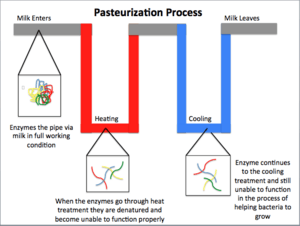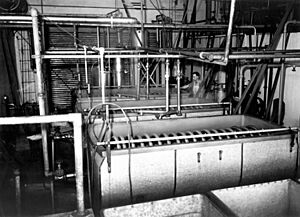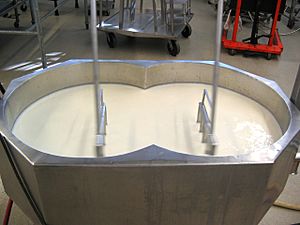Pasteurization facts for kids
Pasteurization is a special way to make foods last longer and be safer to eat. It involves heating food to kill most of the tiny, harmful living things called microorganisms, or germs. People use this process for dairy products like milk, and many other foods. This helps stop them from going bad quickly.
The process is named after Louis Pasteur, a scientist who first figured out how to do it successfully. He and Claude Bernard first used pasteurization on April 20, 1862.
Pasteurization is different from sterilization. Sterilization tries to kill all microorganisms. Pasteurization aims to greatly reduce the number of germs, making them unlikely to cause sickness. This is true if the food is kept cold and eaten before its "sell-by" date. Killing all germs often changes the taste of food too much, so it's not common for everyday foods.
Contents
Milk Pasteurization
Pasteurization is most often used for milk. This idea was first suggested by Franz von Soxhlet in 1886. There are two main ways to pasteurize milk:
- High Temperature/Short Time (HTST): This is the most common method. Milk is heated to 72 degrees Celsius (161.5 degrees Fahrenheit) for at least 15 seconds. Milk labeled simply "pasteurized" usually uses this method.
- Ultra-High Temperature (UHT): This method heats milk to a much higher temperature, 138 degrees Celsius (280 degrees Fahrenheit), for at least two seconds. Milk labeled "ultra-pasteurized" or "UHT" uses this method.
Rules for pasteurization are usually set by national food safety groups. For example, in the United States, the USDA sets these rules. Different rules apply to different dairy products. This depends on how much fat they have and what they will be used for. For instance, the rules for pasteurizing cream are different from those for regular milk.
HTST pasteurized milk usually stays fresh in the refrigerator for two or three weeks. Ultra-pasteurized milk can last much longer when refrigerated, sometimes two or three months. If UHT pasteurization is combined with special packaging, the milk can even be stored without refrigeration for a very long time.
Other Pasteurization Methods
Besides HTST and UHT, there are other ways to pasteurize food.
- Batch Pasteurization: This involves heating large amounts of milk to a lower temperature, usually 68 degrees Celsius (154 degrees Fahrenheit), for a longer time.
- Higher-Heat/Shorter Time (HHST): This method uses temperatures and times that are between HTST and UHT.
Pasteurization can change some of the proteins in milk, but these changes are usually not harmful.
Raw Milk
"Raw milk" is milk that has not been pasteurized. In most places, selling packaged raw milk is not allowed. Some people believe raw milk has health benefits because it contains certain natural things that are destroyed by heat. These include some antibodies and enzymes like lipase. Raw milk also has some vitamin B6, which can be lost during heating. Some people also claim it has good bacteria that help with digestion.
However, many doctors and health experts warn that raw milk can be risky. It might contain harmful germs that can cause serious sickness. Because of this risk, some doctors suggest that certain people should avoid raw milk. This includes pregnant people, those who are breastfeeding, and anyone with a weakened immune system. Babies and young children are also often advised to only drink UHT pasteurized dairy products.
In some parts of Africa, people commonly boil milk right after it's collected. This strong heating changes the milk's flavor, which people there are used to.
Unpasteurized Milk and Safety
Scientists have found that some harmful germs can sometimes survive pasteurization. They use special tests to find these germs in pasteurized milk. One example is a bacterium called Mycobacterium avium subspecies paratuberculosis (MAP). This germ causes a disease in cattle and is thought to be linked to a human disease called Crohn's disease. MAP has been found in pasteurized milk in several countries.
Some experts believe that food safety rules for pasteurization should be looked at again because of these findings. They want to make sure that pasteurization is always effective at killing harmful germs.
A newer method called flash pasteurization uses very short exposure to high temperatures. It is said to be better at keeping the color and taste of some products.
Sometimes, the term "cold pasteurization" is used. This refers to using things like ionizing radiation (also called food irradiation) or chemicals to kill bacteria in food, instead of heat.
Foods Commonly Pasteurized
Images for kids
See also
 In Spanish: Pasteurización para niños
In Spanish: Pasteurización para niños






